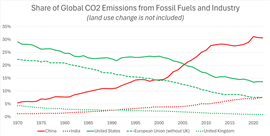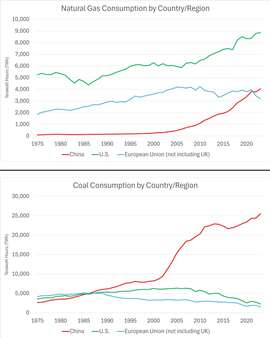Romito highlights global decarbonization challenges at Power Progress Summit: Part 1
03 November 2024
In a world focused on energy transitions in the interest of decarbonization, Dan Romito’s presentation at the 2024 Power Progress Summit asked an interesting question: what if it wasn’t working?
Romito, who is a managing director and partner at Pickering Energy Partners, said a global energy transition is in fact not taking place. “Let’s take the emotion out of the equation. Let’s take the politics out of the equation. And let’s just look at what the data inherently tells us.”
 Data Source: Global Carbon Budget (2023) via Our World in Data (OurWorldinData.org/co2-and-greenhouse-gas-emissions) Graph: KHL Staff
Data Source: Global Carbon Budget (2023) via Our World in Data (OurWorldinData.org/co2-and-greenhouse-gas-emissions) Graph: KHL Staff
Romito contended that a lack of effort to decarbonize on the part of both India and China is significantly diminishing the decarbonization efforts made on both sides of the Atlantic.
“The problem — what no one wants to address, the elephant in the room — is that India and China represent 40 percent of global emissions,” he said. “We can decarbonize all we want. If the United States and Europe, which is collectively one fifth of global emissions, goes to net zero, you still have to account for the other 80 [percent]. That is the problem.”
Natural Gas’ Role
Citing data from the 2023 Global Carbon Budget and OurWorldInData.org, Romito said that while global carbon dioxide (CO2) emissions have increased about 2.5 times since 1970, U.S. CO2 emissions have remained relatively flat since 1975. Such could not be said about China and India, as both countries contribute significantly to the global share of CO2 emissions, with China’s contribution alone having doubled over the past 40 years. One reason, he said, is natural gas.
 Natural gas vs. coal consumption by China, the U.S. and the European Union. (Data: Energy Institute - Statistical Review of World Energy (2024) via Our World in Data at https://ourworldindata.org/grapher/energy-consumption-by-source-and-country. Graphic: KHL Staff)
Natural gas vs. coal consumption by China, the U.S. and the European Union. (Data: Energy Institute - Statistical Review of World Energy (2024) via Our World in Data at https://ourworldindata.org/grapher/energy-consumption-by-source-and-country. Graphic: KHL Staff)
“There is an interesting dynamic taking place in the Western economies that is not yet appreciated to the extent that it should be,” Romito said. “And that dynamic, that variable, lies with natural gas. If we look at how natural gas has penetrated the energy mix in the world, you see that it’s gone from a little bit to a whole lot in a short amount of time.”
Romito cited data from OurWorldInData.org that showed global primary energy consumption of natural gas growing from about 12,000 terawatt hours in 1975 to about 40,000 terawatt hours in 2023. However, Romito said there is “one glaring exception to that trend.”
“China has a massive problem with electricity demand,” he said. “They need to expand energy optionality, because their middle class is now two times greater than the entire population of the United States. And guess what? They don’t use natural gas.”
Romito added that this is problematic, since natural gas fosters decarbonization.
“I don’t know what the next 50 years is going to look like in terms of energy mix,” he said. “I do know that there’s a precedent in place that natural gas in particular has allowed the Western economies to decarbonize.”
The net result of this lack of decarbonization in China and India is a weakening of the decarbonization efforts made by both Europe and the United States.
“If Europe went net zero tomorrow and all things remain constant, which in itself is a conservative estimate, we would be at the global emissions level that we were in 2018,” Romito said, noting that Europe contributes only 7 percent to global CO2 emissions. “In other words, Europe would be paying about $10 trillion just to get back to where we were about seven years ago.”
Decarbonization Priorities
Romito provided additional evidence by analyzing gross domestic product (GDP) and per capita CO2 emissions data for China and India compared to certain Western economies. He said that GDP has grown since 1990 for both China and India as well as the U.S., United Kingdom and Germany. However, China and India have also seen corresponding growth in their per capita CO2 emissions, with Romito saying “there is a linear correlation between those two.”
By comparison, the Western countries have shown dramatic declines in per capita CO2 emissions — ranging from about 20 to 50 percent.
Romito added that this trend is in part the result of large investor-owned companies in the West have making decarbonization a priority.
“Once investors began telling their companies we want you to decarbonize — we want you to focus more on emissions, we want better performance — those companies listened, because what was the simultaneous carrot and stick that they were presented with?” Romito asked. “Do this, or you get no more money. When investors speak, companies listen.”
By contrast, Romito said that state-operated entities (SOE) in China and India have no similar incentives to decarbonize — and aside from legislation, neither do the countries themselves. Romito cited data from the think tank InfluenceMap’s Carbon Majors Database. According to the database, CO2 emissions from nation states have on occasion outpaced investor-owned companies a few times since 1940, with the most recent occurrence happening sometime around 2006 and continuing to the present day. SOE emissions, however, began to outpace investor-owned companies well over 30 years ago — in the late 1980s — and have not stopped since.
Growing Populations
Romito pointed out another dilemma facing decarbonization — population growth, specifically as it relates to the growth of the middle class in China and India.
“We have a massive population increase anticipated over the next 50 years,” he said. “And if we look at where those population increases are taking place, it’s predominantly taking place in developing economies.”
According to Romito, there is no mathematical correlation between high GDP per capita and low energy consumption. That means that as populations in developing countries grow, so will their energy consumption.
Additionally, regarding China and India specifically, Romito noted that their middle classes have expanded and are continuing to grow, which will have an impact on the kinds of energy solutions they choose.
“You have China’s middle class that now is two times the size of the entire United States,” he said. “You have India, which in 2050, their middle class is anticipated to hit a billion people. And in the United States, our middle class is shrinking. So, what do those three components collectively tell us what everyone’s major consideration is when it comes to middle class? Affordability.”
Romito added that when being asked to choose between paying for bills and food and going net zero, they will always choose the former. That means affordability of sustainable energy will continue to be a key focus moving forward — both in developing as well as developed countries.
STAY CONNECTED



Receive the information you need when you need it through our world-leading magazines, newsletters and daily briefings.
CONNECT WITH THE TEAM











